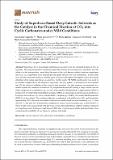Por favor, use este identificador para citar o enlazar a este item:
http://hdl.handle.net/10261/188806COMPARTIR / EXPORTAR:
 SHARE SHARE
 CORE
BASE CORE
BASE
|
|
| Visualizar otros formatos: MARC | Dublin Core | RDF | ORE | MODS | METS | DIDL | DATACITE | |

| Título: | Study of superbase-based deep eutectic solvents as the catalyst in the chemical fixation of CO2 into cyclic carbonates under mild conditions |
Autor: | García-Argüelles, Sara CSIC; Ferrer, M. Luisa CSIC ORCID; Iglesias, Marta CSIC ORCID ; Monte, Francisco del CSIC ORCID; Gutiérrez, María C. CSIC ORCID | Palabras clave: | CO2 absorption Superbases CO2 fixation Eutectic solvents |
Fecha de publicación: | 7-jul-2017 | Editor: | Multidisciplinary Digital Publishing Institute | Citación: | Materials 10(7): 759 (2017) | Resumen: | Superbases have shown high performance as catalysts in the chemical fixation of CO to epoxides. The proposed reaction mechanism typically assumes the formation of a superbase, the CO2 adduct as the intermediate, most likely because of the well-known affinity between superbases and CO, i.e., superbases have actually proven quite effective for CO absorption. In this latter use, concerns about the chemical stability upon successive absorption-desorption cycles also merits attention when using superbases as catalysts. In this work, H NMR spectroscopy was used to get further insights about (1) whether a superbase, the CO adduct, is formed as an intermediate and (2) the chemical stability of the catalyst after reaction. For this purpose, we proposed as a model system the chemical fixation of CO to epichlorohydrin (EP) using a deep eutectic solvent (DES) composed of a superbase, e.g., 2,3,4,6,7,8-hexahydro-1H-pyrimido[1,2-α]pyrimidine (TBD) or 2,3,4,6,7,8,9,10-octahydropyrimido[1,2-a]azepine (DBU), as a hydrogen acceptor and an alcohol as a hydrogen bond donor, e.g., benzyl alcohol (BA), ethylene glycol (EG), and methyldiethanolamine (MDEA), as the catalyst. The resulting carbonate was obtained with yields above 90% and selectivities approaching 100% after only two hours of reaction in pseudo-mild reaction conditions, e.g., 1.2 bars and 100 °C, and after 20 h if the reaction conditions of choice were even milder, e.g., 1.2 bars and 50 °C. These results were in agreement with previous works using bifunctional catalytic systems composed of a superbase and a hydrogen bond donor (HBD) also reporting good yields and selectivities, thus confirming the suitability of our choice to perform this study. | Versión del editor: | https://doi.org/10.3390/ma10070759 | URI: | http://hdl.handle.net/10261/188806 | DOI: | 10.3390/ma10070759 | Identificadores: | doi: 10.3390/ma10070759 issn: 1996-1944 e-issn: 1996-1944 |
| Aparece en las colecciones: | (ICMM) Artículos |
Ficheros en este ítem:
| Fichero | Descripción | Tamaño | Formato | |
|---|---|---|---|---|
| study_superbase-based_deep_eutectic_solvents_catalyst_chemical_fixation.pdf | 1,99 MB | Adobe PDF |  Visualizar/Abrir |
CORE Recommender
PubMed Central
Citations
3
checked on 17-abr-2024
SCOPUSTM
Citations
24
checked on 19-abr-2024
WEB OF SCIENCETM
Citations
21
checked on 29-feb-2024
Page view(s)
118
checked on 23-abr-2024
Download(s)
43
checked on 23-abr-2024

